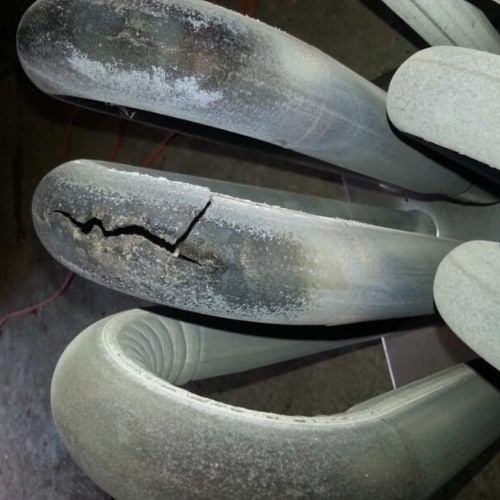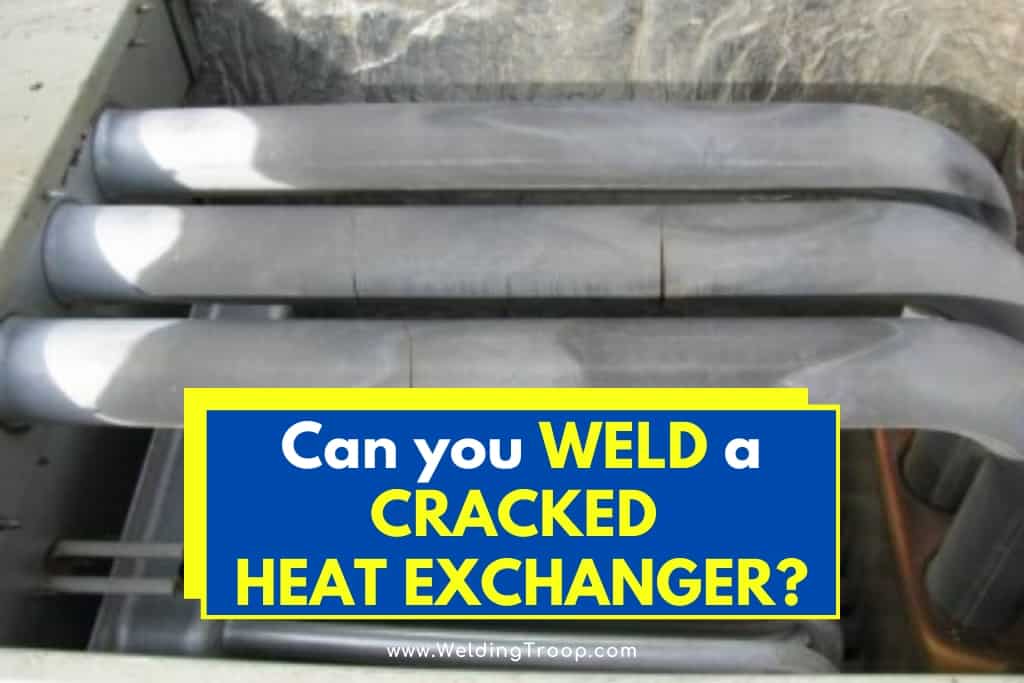Like any other machine or appliance, heating systems need routine maintenance to extend their working life. Heat exchangers need regular inspections. These rugged pieces of equipment are subject to rapid and extreme fluctuations in temperature and to rusting, which can cause failure. A cracked heat exchanger is a safety hazard and cannot be ignored. The question is whether welding is an option to repair a cracked heat exchanger.
Can you weld a heat exchanger? NO! Cracked heat exchangers should not be welded or repaired. Repairing a cracked heat exchanger requires welding both sides of the crack to ensure stopping all leaks. In most residential and small commercial heating units, this is not possible.
Welding is not an option when it comes to a cracked heat exchanger, but it may not be necessary in the first place. This guide will explain why you can’t weld a heat exchanger. It will also help you understand how your heating system works, and the symptoms of a cracked heat exchanger.
Table of Contents
Why Welding a Cracked Heat Exchanger is not an Option
There are several reasons that welding a heat exchanger is not a viable option.
- Safety
- Cost
- Functionality
Safety
The number one reason that welding a heat exchanger to repair a crack or leak repair is considered bad practice is the safety factor. Heat exchangers designs keep the combustion gasses from mixing with the air in your home or business. No reputable welder will guarantee that they can weld a crack or leak in a heat exchanger that won’t continue to leak.

No one would knowingly put a repaired heat exchanger back into service, knowing that the heat exchanger may continue to leak toxic gasses into the home. The safety concerns far outweigh any monetary consideration.
Some of the materials used to exchangers would require a welder to make welding passes on both sides of the crack or leak. The size and shape of most heat exchangers make this impossible.
Cost
Just the labor to disassemble, weld properly, and reassemble the furnace is more than the cost and installation of a new heat exchanger. In some cases, the cost of the repair would exceed the cost of a new furnace. Economically it just does not make sense to repair a heat exchanger.
Functionality
The heat exchanger, burner, and fans on most new HVAC systems operate as balanced systems. Any kind of repair or alteration to any part of those systems can cause the whole HVAC unit to run in ways that can affect its efficiency and safety.
What Does a Heat Exchanger do?
Well, the name is descriptive. The job of the heat exchanger in your furnace is to move the heat from the gas or oil burners to the air in your home safely. The heat exchanger does this by
- Burning the fuel in the heat exchanger and warming the metal
- Separating the heated gases of combustion from the air inside your home
- Transferring the heat to the air in your home as it passes over the hot metal of the heat exchanger
- Venting the dangerous and toxic gases from the combustion process outside your home
The heat exchanger is, in many ways, a safety device as much as it is a mechanical device. Without the heat exchanger, the toxic combustion gases would be mixed with the air in your home, creating a health hazard for you and your family. A crack in a heat exchanger allows this mixing to occur and can create dangerous conditions inside your home.
How Do I Diagnosis a Cracked Heat Exchanger?
The number one indicator of a broken or cracked heat exchanger is a carbon monoxide detector that is alarming and alarms again after a reset when the heater comes on. If you don’t have carbon monoxide detectors and you use any kind of heating system that burns gas or oil, you are playing a dangerous game. A carbon monoxide detector can sense levels of this deadly gas before they reach toxic levels.
If you or anyone in your family begins to suffer from headaches or other flu-like symptoms for no apparent reason, you should immediately suspect carbon monoxide poisoning. Some of the symptoms include
- Nose and eye irritation
- Nausea
- Sleepiness
- Disorientation
- Headaches
If you or anyone in your family suffers from these symptoms but they disappear when you leave your home, have a trained professional immediately test the air quality in your home and inspect your furnace.
There are other signs and symptoms of a cracked heat exchanger that can alert you to a problem without having to disassemble your entire furnace to make a visual inspection.
- Carbon Deposits – If the inside of your furnace starts to show a build-up of carbon deposits, you should suspect a cracked heat exchanger. Carbon deposits, often called soot, are the result of incomplete combustion, which can be caused by a cracked heat exchanger.
- Flame Appearance – A gas furnace should burn with a steady blue flame when it is running. The appearance of yellow flames dancing and moving over the surface of the burner is a sign of a cracked heat exchanger
- Visible Damage – You may be able to look at a portion of your heat exchanger from the front access panel of your heating unit. The areas around the burners are most susceptible to cracking and rust through, and on some units, this portion of the heat exchangers is visible.
Be Careful of the Scammers
Other things can cause some of the symptoms listed above. Improperly adjusted burners are one such cause. Fortunately, unless the burners are damaged, the adjustments are relatively easy and often inexpensive. Damaged burners are replaceable as well.
Unfortunately, some unscrupulous HVAC technicians will insist that a cracked or rusted heat exchanger is the cause of your problems to convince you to purchase a whole new HVAC system for your home.
The easiest way to prevent this is to get several opinions from different HVAC technicians. If all of the diagnosis indicates a cracked heat exchanger and you decide that replacing your entire system is the best alternative, you should still insist that upon removal of the old system, you are shown the cracked or damaged heat exchanger. Reputable HVAC companies will have no problem with this request.
Why Do Heat Exchanger Fail?
This is a reasonable question. Heat exchangers have no moving parts to wear out. They are not subject to movement or vibration. What is it that causes a heat exchanger to crack or rust to the point of failure?
According to industry experts, the number one reason that heat exchangers crack is a lack of airflow through the heat exchanger. The real killer of heat exchangers is the stress placed on the metal as it repeatedly heats and cools. This repeated heating and cooling causes the metal to expand and contract continually.
Without enough airflow through the heat exchanger, the metal overheats, causing more expansion and contraction, which causes stress cracking along bends or welds. Several problems can cause this lack of airflow through the heat exchanger.
- Dirty Air Filters – Failing to keep the air filters in your furnace clean can be a cause for excess heating. The simple act of changing the air filters in your HVAC system regularly can extend the life of your heat exchanger for many years.
- Oversized Heating System – Having too much furnace can be another culprit in the cracked heat exchanger problem. A furnace too large for your home causes the system to cycle so quickly that water condenses inside the heat exchanger. This moisture eventually collects in nooks and crannies and causes rusts with eats through the metal of the heat exchanger, causing leaks.
- Improper Ductwork – One problem seen by many HVAC technicians is improperly sized ductwork for the furnace. Often homeowners will replace an HVAC system but attach it to old ductwork that cannot handle the airflow of the new furnace. The improperly sized ductwork causes the system to burn longer and to move less air through the heat exchanger, causing overheating and eventually cracking.
- Blocked or Damaged Vents – If the vent pipe that carried the toxic gases outside your home becomes blocked or damaged, the system will suffer. These poisonous gases can leave caustic and damaging substances inside the heat exchanger if they cannot vent properly, resulting in rusting, pitting, or overheating in the heat exchanger.
Don’t Take a Furnace Problem Lightly
If you suspect that your furnace has a cracked or damaged heat exchanger, find a competent professional HVAC technician to look at your system immediately. Carbon monoxide poisoning is a dangerous and deadly event. Experts estimate that about 500 people in the US die from carbon monoxide poisoning, mostly from defective gas or oil-fired furnaces.
If you have any gas-fired appliances in your home, whether they are furnaces, water heaters, or cookstoves, you should follow some best practices.
- Install enough carbon monoxide detectors or adequately cover your home.
- Inspect your gas-fired appliances regularly
- Have the ductwork and vents on your gas heating equipment inspected annually
- Replace the filters on your gas-fired equipment regularly as recommended by the manufacturer
- Don’t use a gas cookstove for heating
Operating and maintaining your gas-fired equipment properly extends the life of this equipment for many years. Failing to inspect and maintain gas-fired heating equipment can have deadly consequences.
What is a Heat Exchanger? >> Check out the video below

